A simple tutorial and fresh pasta recipe for making homemade pasta in minutes with or without using a pasta maker.
You’ll never want to buy a box of dry pasta again!
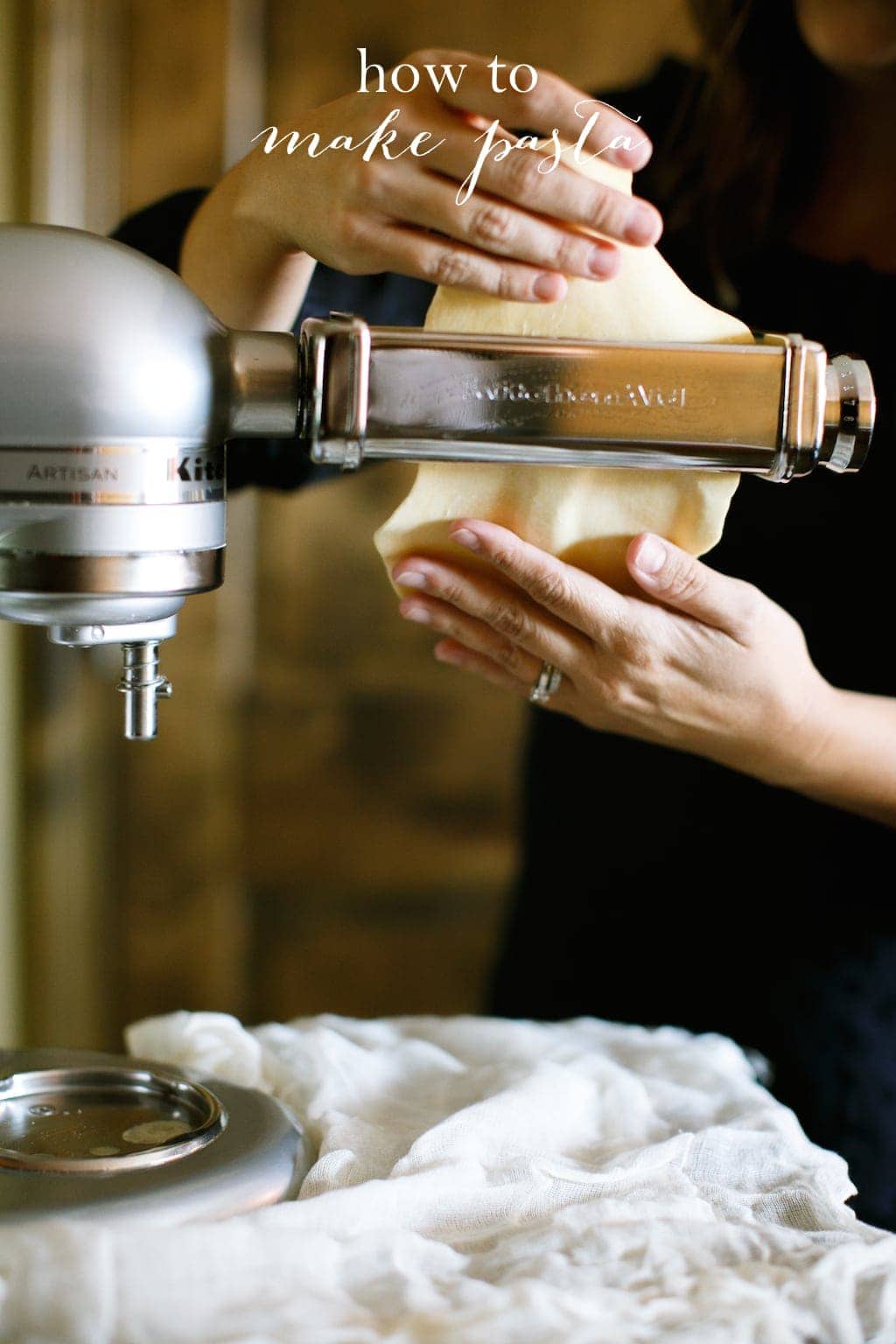
A few years ago, I invested in the pasta maker attachment for my Kitchenaid mixer and I have never looked back. If I had only known how easy it was to make fresh pasta, I would have tossed the boxes away years ago!
In fact, we have enjoyed it so much, that I have purchased additional pasta roller attachments as well. The options are endless when you are making homemade pasta.
Let me just say it here, homemade pasta is delicious and so much easier than you might think!
The Best Homemade Pasta Recipes
Pasta is an incredible comfort food, and it’s been one of my favorite foods for my entire life. I’ve shared many pasta recipes with you over the years, so don’t ever listen to me if you’re trying to watch your carb intake.
Topped with savory red sauces like Amatriciana, Vodka Sauce, or Tomato Sauce, or white sauce like Alfredo, Cacio e Pepe, or simply butter with salt and pepper. There is not a pasta dish that I don’t love!
Learn How to Cook Pasta right here, with all my favorite tips and tricks.
A homemade pasta recipe can be so versatile, becoming the perfect base for almost every Italian meal.

Why You’ll Love Making Your Own Homemade Pasta
- Pasta is very family-friendly! Who doesn’t love a spaghetti dinner? Like all good meals, it brings people together.
- My girls love to help me in the kitchen and making pasta is no exception! They love to measure out the ingredients, roll the pasta dough, and could watch the pasta come out the pasta machine for days! Those times are memories I will cherish forever.
- Homemade pasta is also very budget friendly. It costs no more to make your own pasta than it does to buy a box at the store. In my opinion, homemade pasta is the gourmet choice between the two.
- In addition, it is more delicious topped with your favorite sauce and it can be served for any event.
- While tools are handy, you don’t need anything special to make homemade pasta!
- This is a very quick process. I typically spend only 15 minutes making the dough and pressing it through the pasta maker attachment.
- The dough is only a few ingredients and rolling it through the pasta maker can be done in a snap.
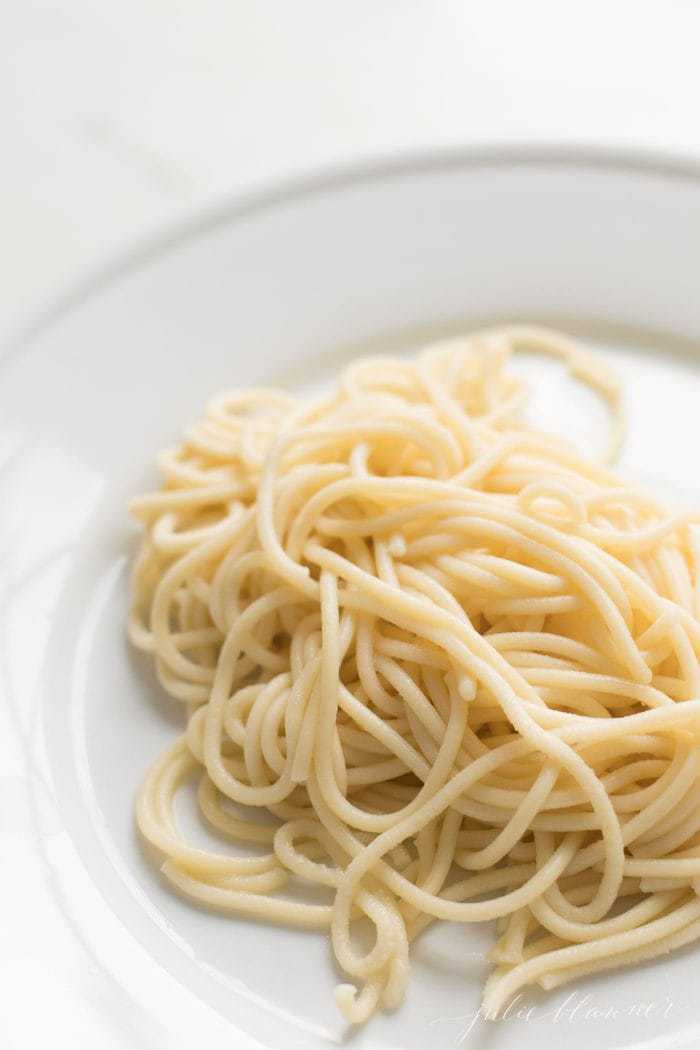
Tools to Make Homemade Pasta
Before we get to the ingredients, you’ll need to know about TOOLS.
You don’t need any of these specific tools to make homemade pasta, but they can make your life a little easier, and more fun!
- Kitchen Aid Pasta Maker Attachment
- Kitchen Aid Pasta Roller Attachment
- Hand Crank Pasta Machine and Cutter
- Pasta Drying Rack
- Don’t have a KitchenAid stand mixer? Roll by hand using a simple rolling pin and pizza cutter.
Tools or no tools, I know it can be intimidating if you’ve never done this before.
However, even without the shortcut attachments, I think it is worth the extra few minutes to roll out the dough by hand and use a rolling pin and pizza cutter to make the pasta shape you desire.
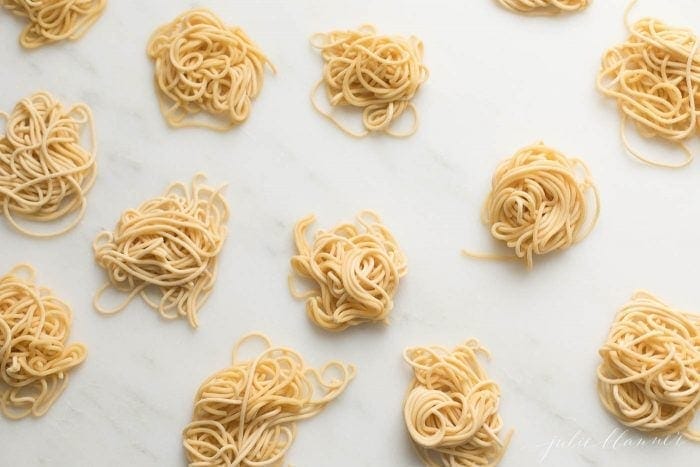
The ingredients for pasta are really simple and likely are already on hand in your pantry. A basic noodle recipe usually consists of equal parts of white flour and semolina flour, olive oil (or butter), eggs, and water.
Homemade Pasta Ingredients
Full ingredient amounts and directions are in the printable recipe card at the bottom of this post.
- Flour – All purpose will work just fine, but I prefer to use equal parts all purpose and semolina flour. (Read more about semolina below.)
- Eggs – The binding agent for fresh pasta.
- Salt – A hint of salt for added flavor. A finely ground salt is best here.
- Water – to moisten your dough as needed.
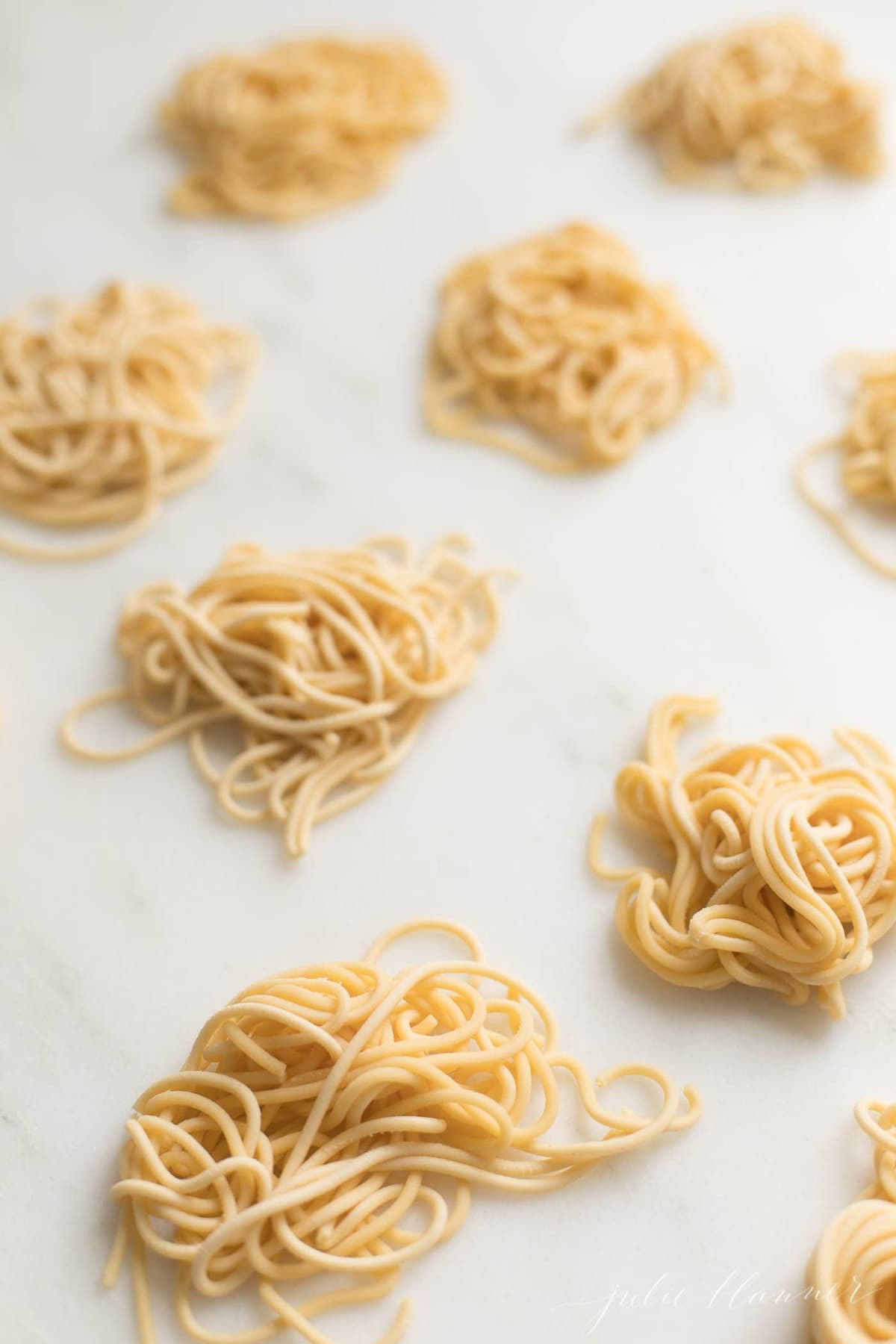
How to Make Homemade Pasta
- Combine – In a stand mixer or mixing bowl, combine flour, eggs and 2 tablespoons water with your paddle attachment. You don’t want the dough to be crumbly or sticky…just doughy! Add an additional tablespoon of water at a time until you reach the desired consistency on speed 4.
- Knead – With a stand mixer fitted with a dough hook knead for 2 minutes on speed 4, or knead by hand on a lightly floured surface .
- Make Pasta Sheets – Set the pasta roller attachment on level 1. Make a flat dough ball and feed through. I usually like to do this on speed 4…fast enough, but not too fast. Continue to place the dough through increasing the setting each time – level 2, 3, 4 and finally 5 for fettuccine. Do this with all of your dough. You have to gage your dough…if it is too sticky, add a little flour to your hands and recreate your dough ball. If it appears to be too dry and not smooth enough, add a touch of water to your hands and recreate your dough ball. You’ll get the hang of this in no time! By hand: roll out on a floured surface with a rolling pin.
- Make Pasta Noodles – Switch to your fettuccine or linguini attachment unless you’re making pappardelle or ravioli. Feed the dough through, catching the noodles with your other hand and immediately place into your pot of boiling water. By hand: Use a pizza cutter to create noodles.
- Boil Noodles – In a pot of salted, boiling water, boil noodles 3 minutes. Toss with sauce and serve or follow the instructions below to store.
Tips
Substitutions and Variations
- Semolina Flour – In this recipe I only call for one type of flour and the noodles turn out beautifully. However, you can substitute half the flour with semolina flour for a more traditional noodle. Semolina flour is a more coarsely ground wheat and has a yellowish color. Most local supermarkets keep this in stock.
- Gluten Free – Feel free to experiment with gluten free flour mixes for a homemade gluten free noodle. Bob’s Red Mill Gluten Free 1-to-1 Baking Flour is a great substitution.
- Arugula Pasta – Add 5 ounces of arugula to a food processor. Combine with flour, eggs, salt and water.
- Spinach Pasta – Add 5 ounces of spinach to a food processor. Combine with flour, eggs, salt and water.
Pasta is very forgiving. Don’t be afraid to substitute, take risks and try something new!
Consistency
- Dough should not be at all sticky when you run it through your pasta maker or it will stick to the machine. If your dough feels sticky sprinkle lightly with flour.
- If your noodles end up a little crumbly or gummy it is most likely because the dough is under developed and needed a little more kneading.
- You can let your pasta dough rest for 30 minutes after kneading to let the gluten relax. Letting the gluten relax after kneading makes for a loser dough and is easier to mold into more intricate noodle shapes.
By Hand
- If you are rolling the pasta dough out by hand, use a lightly floured surface. Roll the dough our very thinly. Don’t worry about too much extra flour as it will shake off as you cut the pasta or rinse off in the boiling water when cooking.
- Fresh pasta can be cooked right away.
- Bring a pot of water to a boil on the stove with 1/2 teaspoon of salt. Add the noodles and cook for about four minutes stirring occasionally.
- Drain over the sink in a colander and then toss with 1 teaspoon of olive oil to prevent the noodles from sticking together. Top with your desired sauce and serve!
How to Cook Fresh Pasta
Fresh pasta can be cooked immediately. Fill a pot with water and add 1 tablespoon salt. Bring water to a rolling boil over high heat. Add noodles and cook approximately 4 minutes, stirring occasionally until al dente. Using tongs or a pasta fork, transfer pasta to sauce and toss.
Cooking and Baking Tips, Substitutions & Guides
How to Cook Pasta
It’s time to master the basics of cooking and learn how to cook pasta the right way! Whether you’re making spaghetti and meatballs for the kids or fettuccine alfredo for a date night in, you’ll nail it with these simple tips. Read More
What Are the Different Types of Pasta?
The shapes of pasta are almost endless! Favorite homemade pasta shapes in my house include angel hair, fettuccine, linguine, pappardelle, bucatini and of course the classic spaghetti noodle!
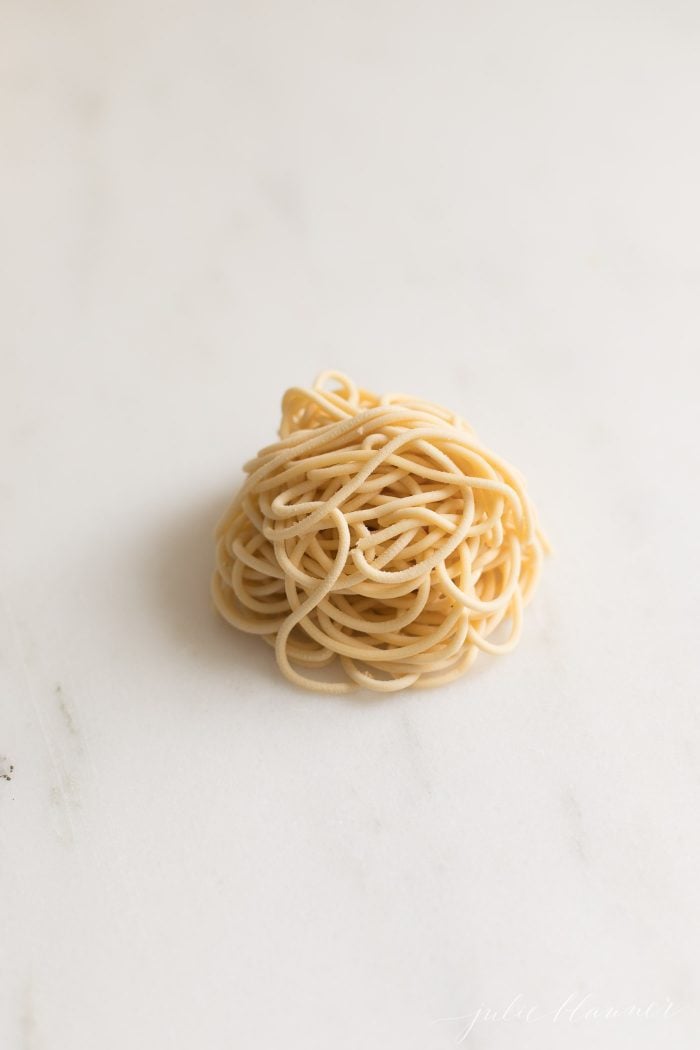
How to Store Fresh Pasta
To Dry
- After the pasta is cut or pressed, hang over a drying rack or lay out on the counter with plenty of space between each noodle and let air dry. (30 minutes at a minimum but can take up to 12-24 hours.)
- Turn the noodles periodically to keep them from sticking to the surface they are on. You can also cover them with a towel to keep any dust from settling on them while they dry. Store in an airtight container.
To Refrigerate
- Place fresh noodles on a baking sheet for 2-3 minutes.
- Dust with flour and loosely fold them into nests. Allow them to dry another 30 minutes.
- Place in an airtight container and store refrigerated 2-3 days.
To Freeze
- Store in an airtight container. Keeps well up to three months.
- To Use: Add frozen pasta to a pot of salty boiling water and prepare al dente.
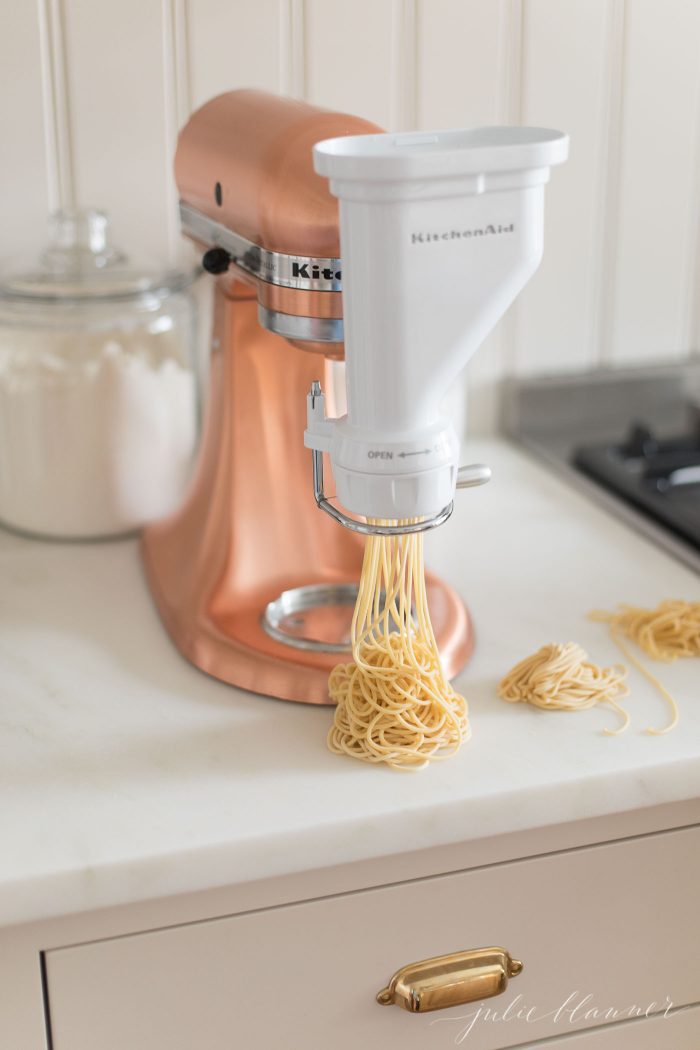
If you love pasta as much as I do, don’t be intimidated, go ahead and try it! After the first time or two, you’ll have noodles ready almost as quick as it takes to prepare them from a box.
You can buy a good pasta but when you cook it yourself it has another feeling.
-Agnes Varda
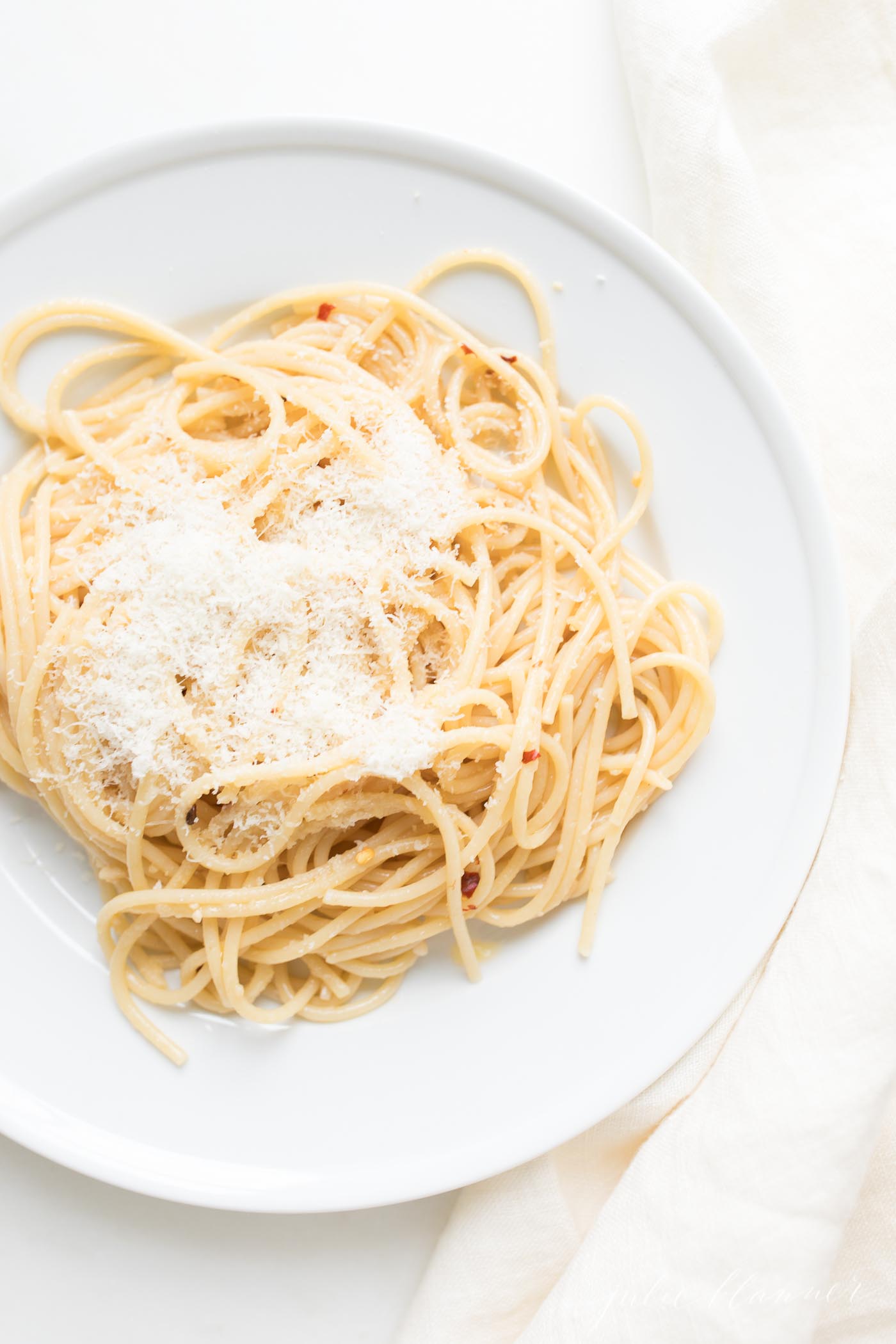
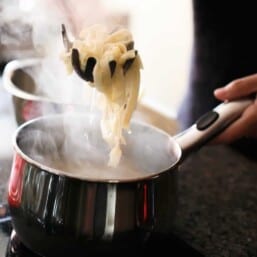
Homemade Pasta
Ingredients
- 3½ cups semolina flour substitute all purpose
- 4 eggs
- water 2 tablespoons at a time, up to ¼ cup
Instructions
- Combine flour, eggs and water with your paddle attachment. You don’t want the dough to be crumbly or sticky…just doughy! Add an additional tablespoon until you reach the desired consistency, mixing on speed 4.
- Using your dough hook, knead for 2 minutes on speed 4.
- Put your pasta roller attachment on level 1. Make a flat dough ball and feed through. I usually like to do this on speed 4…fast enough, but not too fast. Continue to place the dough through increasing the setting each time…level 2, 3, 4 and finally 5 for fettuccine. Do this with all of your dough.
- Switch to your fettuccine or linguini attachment unless you’re making pappardelle or ravioli. Feed the dough through, catching the noodles with your other hand and immediately place into your pot of boiling water.
- Boil noodles 3 minutes & drain.
Julie’s Tips
Substitutions and Variations
- Semolina Flour – In this recipe I only call for one type of flour and the noodles turn out beautifully. However, you can substitute half the flour with semolina flour for a more traditional noodle. Semolina flour is a more coarsely ground wheat and has a yellowish color. Most local supermarkets keep this in stock.
- Gluten Free – Feel free to experiment with gluten free flour mixes for a homemade gluten free noodle. Bob’s Red Mill Gluten Free 1-to-1 Baking Flour is a great substitution.
- Arugula Pasta – Add 5 ounces of arugula to a food processor. Combine with flour, eggs, salt and water.
- Spinach Pasta – Add 5 ounces of spinach to a food processor. Combine with flour, eggs, salt and water.
Consistency
- Dough should not be at all sticky when you run it through your pasta maker or it will stick to the machine. If your dough feels sticky sprinkle lightly with flour.
- If your noodles end up a little crumbly or gummy it is most likely because the dough is under developed and needed a little more kneading.
- You can let your pasta dough rest for 30 minutes after kneading to let the gluten relax. Letting the gluten relax after kneading makes for a loser dough and is easier to mold into more intricate noodle shapes.
By Hand
- If you are rolling the pasta dough out by hand, use a lightly floured surface. Roll the dough our very thinly. Don’t worry about too much extra flour as it will shake off as you cut the pasta or rinse off in the boiling water when cooking.
How to Store Fresh Pasta
- To Dry –After the pasta is cut or pressed, hang over a drying rack or lay out on the counter with plenty of space between each noodle and let air dry. (30 minutes at a minimum but can take up to 12-24 hours.) Turn the noodles periodically to keep them from sticking to the surface they are on. You can also cover them with a towel to keep any dust from settling on them while they dry. Store in an airtight container.
- To Refrigerate – Place fresh noodles on a baking sheet for 2-3 minutes. Dust with flour and loosely fold them into nests. Allow them to dry another 30 minutes. Place in an airtight container and store refrigerated 2-3 days.
- To Freeze – Store in an airtight container. Keeps well up to three months. To Use: Add frozen pasta to a pot of salty boiling water and prepare al dente.
Video
Estimated nutrition information is provided as a courtesy and is not guaranteed.
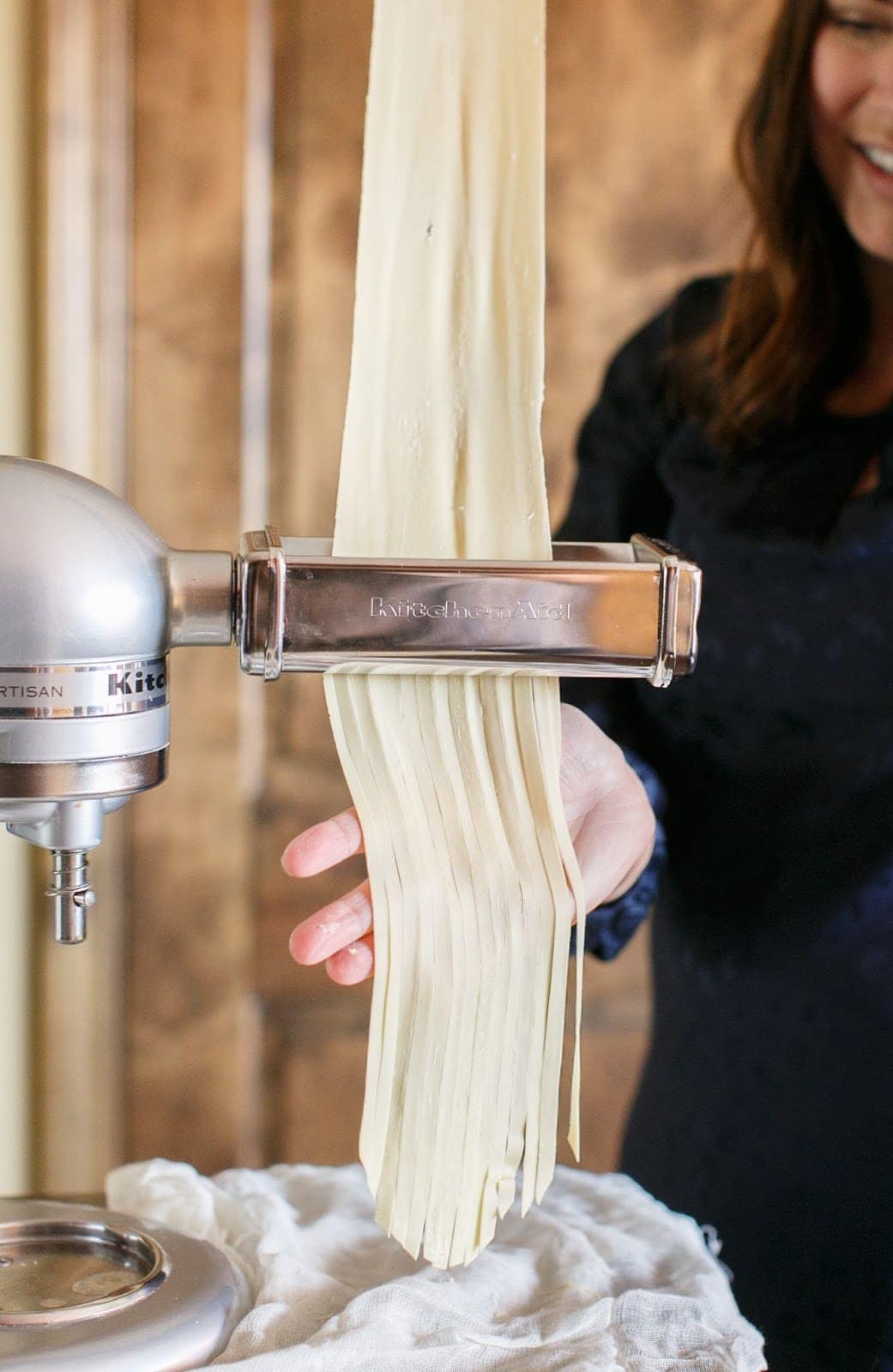
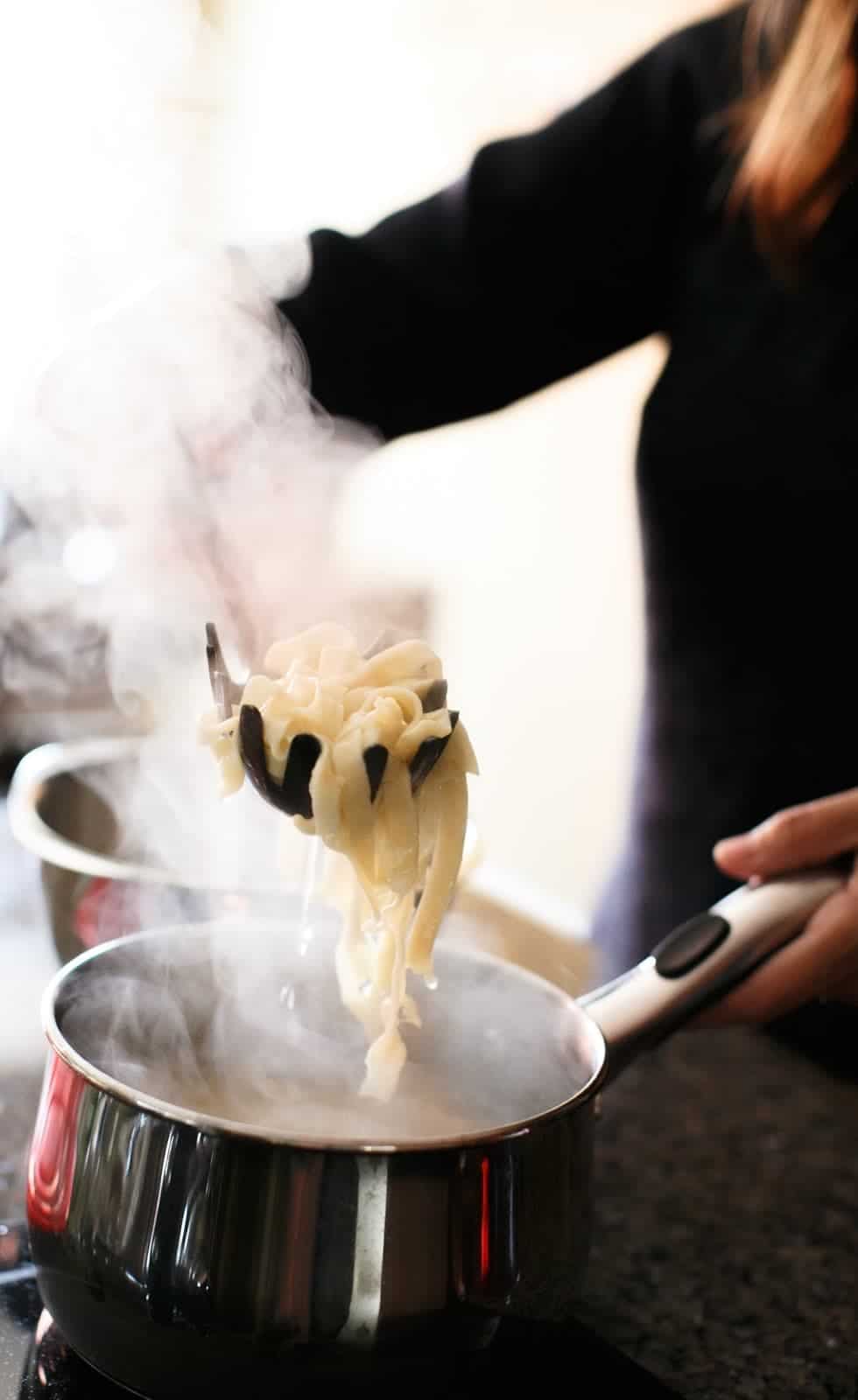
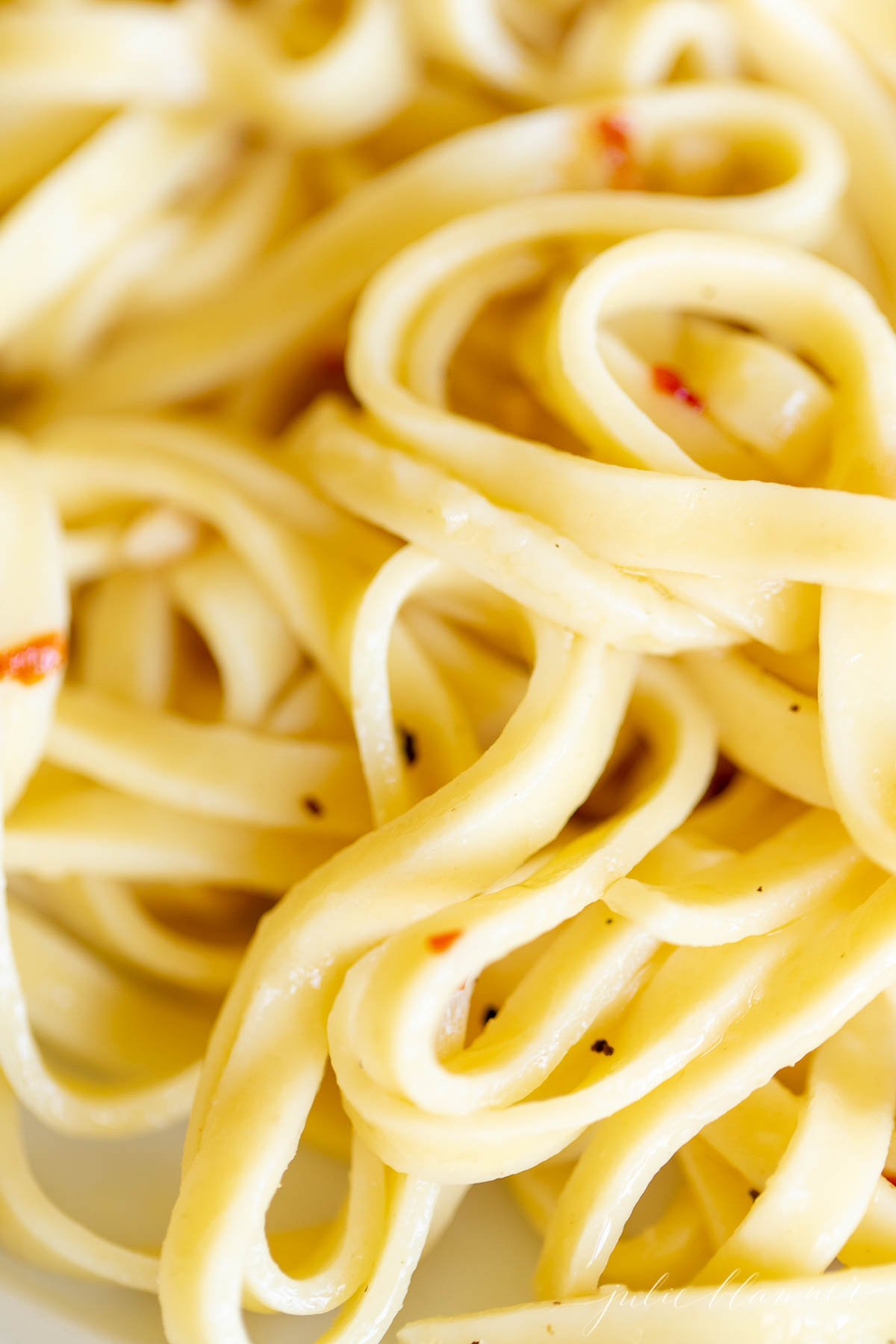
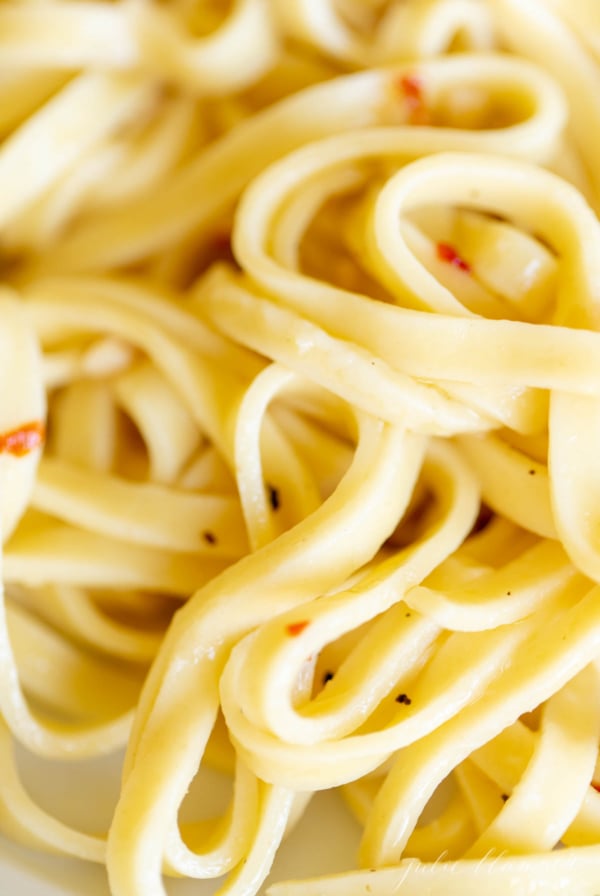
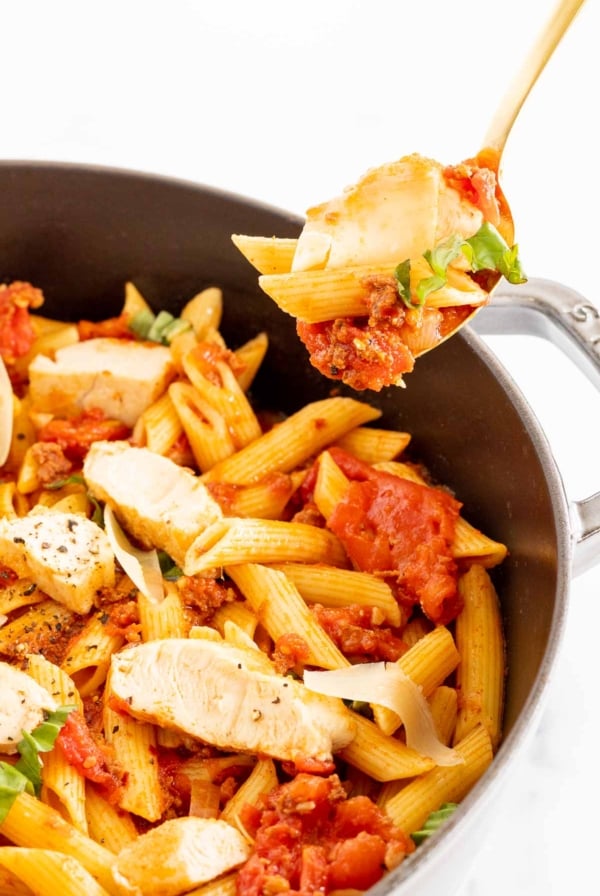
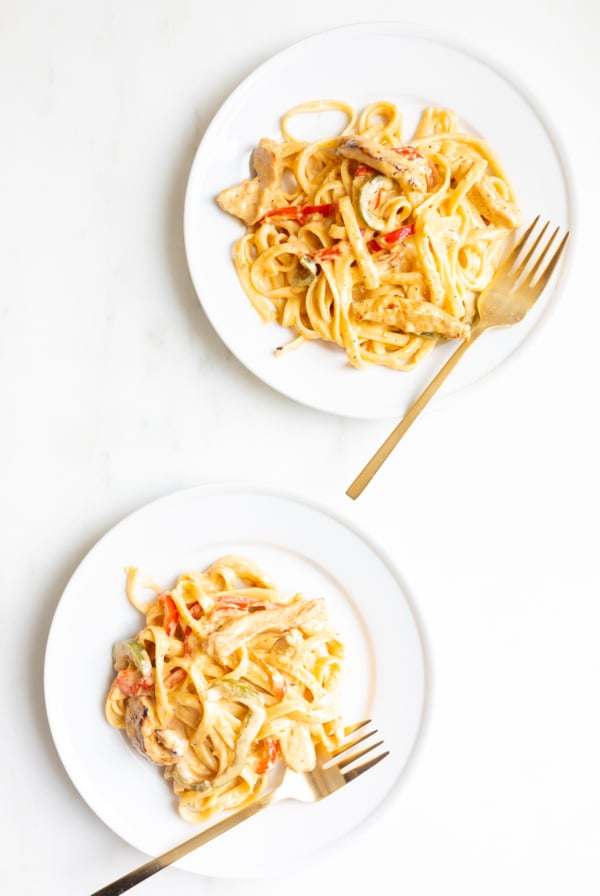
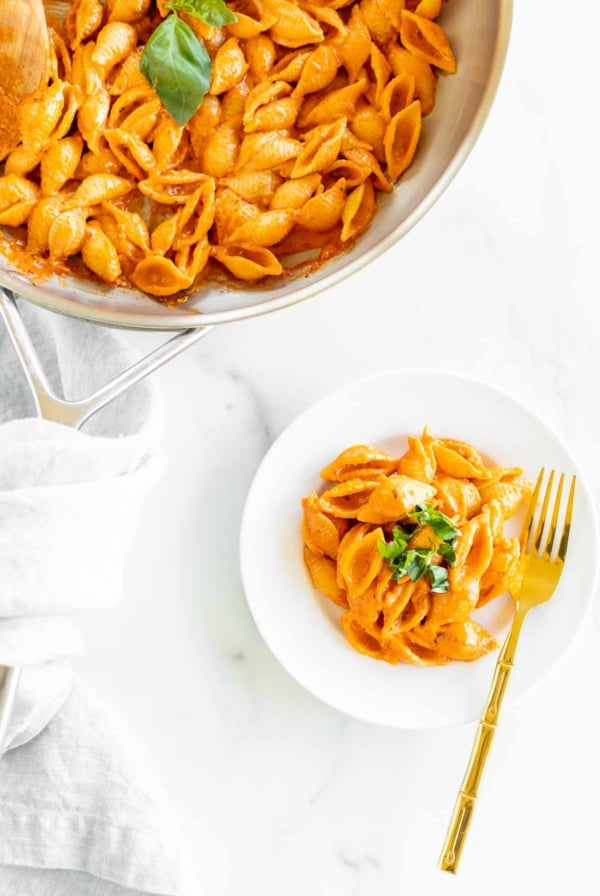
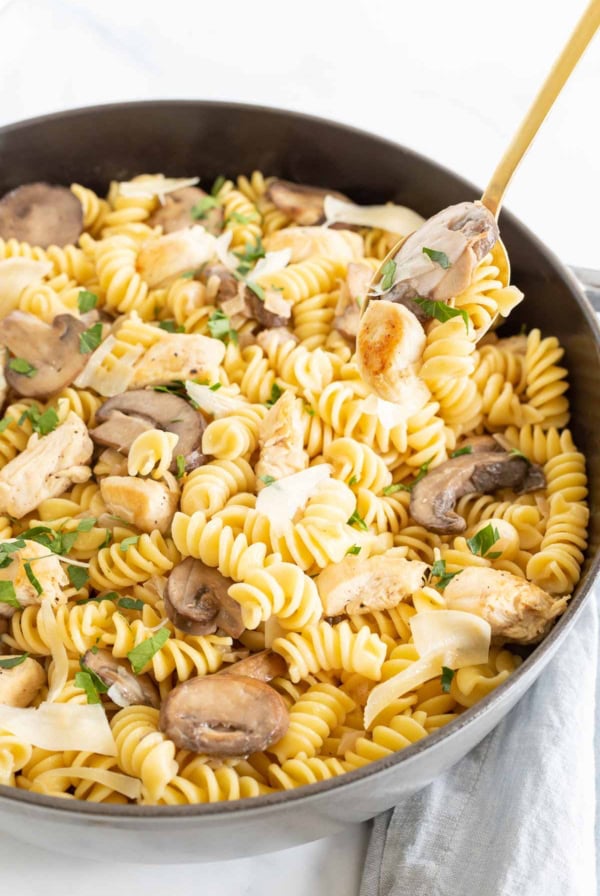
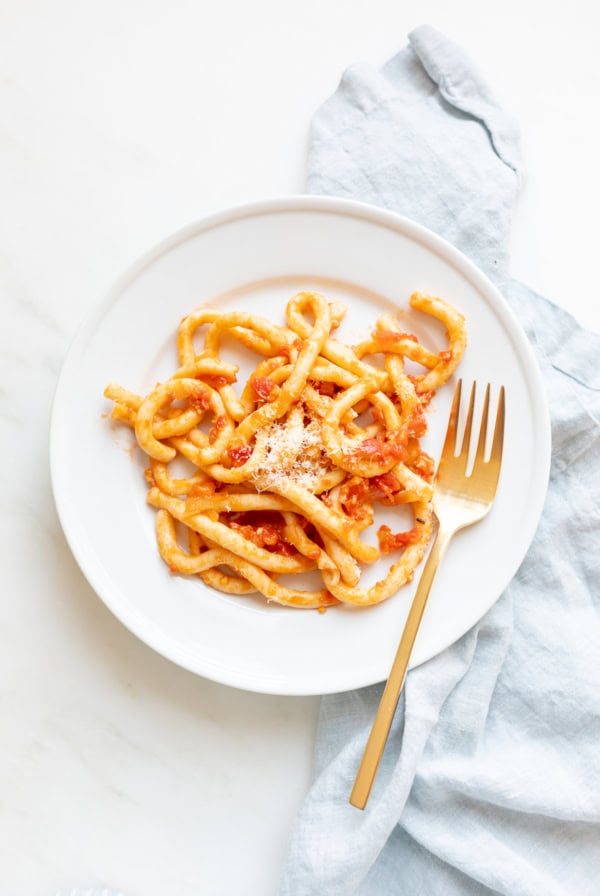
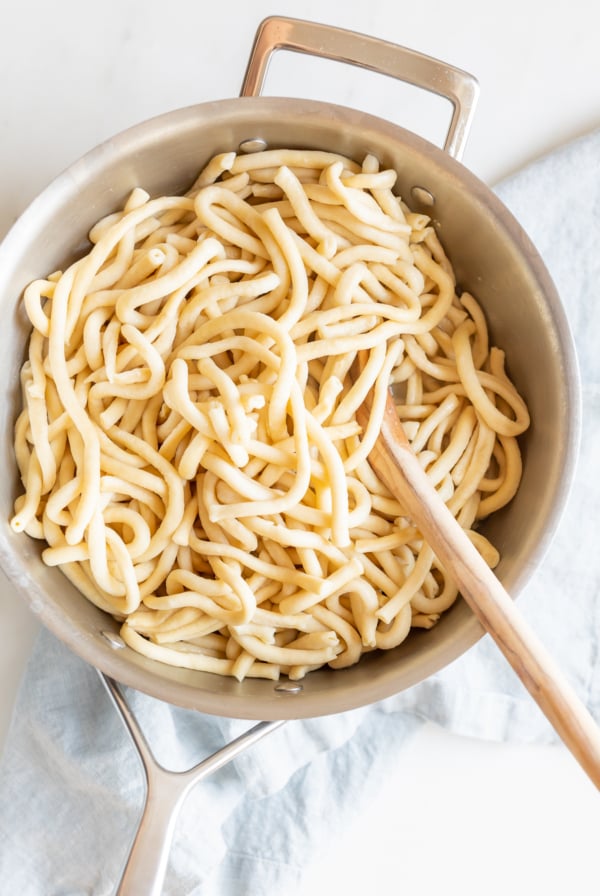






Can you use this dough for ravioli?
Absolutely! We do all the time! Enjoy!
Is this recipe able to be doubled or should I make 2 seperate batches?
You can double it if you have a large mixer. Enjoy!
Hi Julie from the land down under. My question is : why is it recommended when making lasagne using fresh pasta sheets to boil them first before layering them. Surely they would cook in the oven given the time the lasagne takes to cook? I use the pasta without this step as I find it too cumbersome handling wet sticky sheets and haven’t noticed any difference in taste or texture.
That’s brilliant! I’ve just never done it that way before but couldn’t agree more! I’ll do the same, thanks for sharing!
…but I’m not using the box kind…I’m making my own pasta. Have you ever made it?
I’m sorry Kim, I thought your previous question was in regards to my lasagna recipe. Please forgive me ;). I make fresh pasta weekly. I usually boil it right away, but will dry on occasion to save or gift.
I’m making lasagna this weekend. Do I want to boil my rolled pasta before I bake, or assemble it raw and let oven cook it?
If you use oven ready, assemble it raw {that’s what I do to make it so quickly}. If you use regular lasagna, boil it first. You are going to looooove it! Have a great weekend, Kim!
Boil it for about 3 minutes. Enjoy!